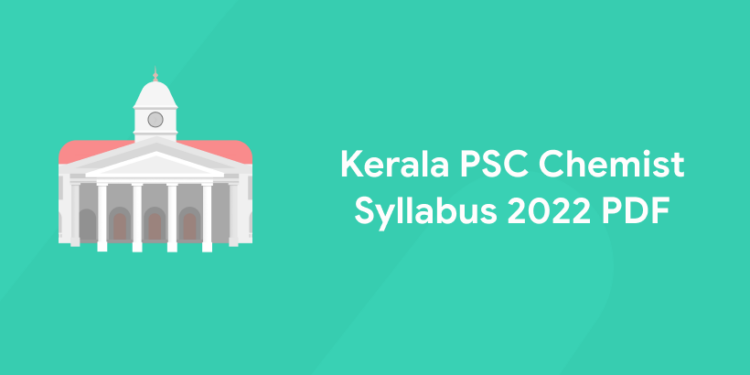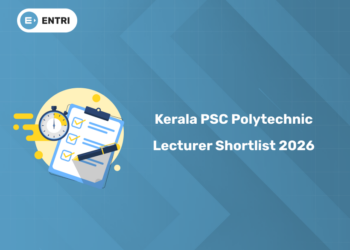Table of Contents
Kerala Public Service Commission has issued the official notification for the recruitment of the candidates for the post of Kerala PSC Chemist in the Cooperative Marketing federation Products Limited Department. The number of applicants is comparatively high as this is one of the prestigious exams conducted by Kerala PSC. The recruitment will be based on the Objective type test followed by the interview. Those candidates who are interested in the post can start the preparation now. The Kerala PSC Chemist exam will be conducted on 24/4/2022 under category number 305/2021. Visit the official website of Kerala PSC for more details.
Kerala PSC Chemist Exam Pattern
The Kerala PSC has released the official notification declaring the exam dates of the upcoming Kerala PSC Chemist exam 2022. The exam will be conducted under the coordination of the Cooperative Marketing federation Products Limited Department. The candidates who are preparing for the exam should be aware of the exam pattern and the syllabus of the exam. The updated exam pattern plays a crucial role in the selection process. The exam will be conducted for 100 marks. The exam will be an objective type test that is based on the OMR / online valuation. The candidates can start the preparation at the earliest. The detailed exam pattern is given below for the candidates to refer to.
| Topics under consideration | Maximum Marks |
| Coordination chemistry, metallurgy, and bioinorganic chemistry.
|
10 |
| Organic reaction mechanism and stereochemistry.
|
7 |
| Qualitative and quantitative aspects of analysis.
|
7 |
| Carbonyl compounds, carboxylic acids, and their derivatives | 6 |
| Gaseous, liquid, and solid states | 6 |
| Electrochemistry | 6 |
| Atomic structure and chemical bonding.
|
10 |
| Molecular spectroscopy | 6 |
| Organometallic compounds.
|
7 |
| Chemical kinetics, surface chemistry, and catalysis | 6 |
| Chemical thermodynamics | 6 |
| Alcohols, phenols, ethers, epoxides, and nitrogen compounds | 6 |
| Ionic and chemical equilibria, phase equilibria | 6 |
| Aliphatic and aromatic hydrocarbons.
|
7 |
| Halogenated hydrocarbons and heterocyclic compounds | 6 |
Grab the latest Kerala PSC study material! Register here!
Kerala PSC Chemist Syllabus
1: Which Year First Assembly Election was held in Kerala?
Those candidates who are preparing for the Kerala PSC Chemist exam 2022 can use the syllabus given below for detailed reference. The candidates should get hold of the detailed syllabus. The syllabus should be covered in detail. The candidates should give extra time to cover the entire topic. The syllabus should be focused. The focal points should be specially noted. The candidates should visit the official website for more details. The detailed syllabus is given below. The candidates can refer to the syllabus and start the preparation.
Atomic structure and chemical bonding
- Bohr’s theory
- Atomic spectrum of the hydrogen atom
- De Broglie equation
- Heisenberg’s Uncertainty Principle
- Schrödinger’s wave equation
- Quantum numbers and their significance
- Shapes of s, p, d, and f orbitals
- Pauli’s Exclusion Principle
- Hund’s rule of maximum multiplicity
- Aufbau’s principle
- Variation of orbital energy with atomic number
- S, p, d, f block elements, and their properties
- Shielding effect
- Slater rules
- Variation of effective nuclear charge in the periodic table
- Ionization enthalpy
- Factors affecting ionization energy
- Applications of ionization enthalpy
- Electron gain enthalpy
- Trends of electron gain enthalpy
- Electronegativity
- Pauling’s/ Mulliken’s and Allred Rachow’s electronegativity scales
- Hybridization, Inert pair effect, the relative stability of different oxidation states
- Diagonal relationship and anomalous behavior of the first member of each group
- Structure, bonding, preparation, properties, and uses of boric acid and borates
- Boron nitrides, borohydrides (diborane), carboranes, silanes, Oxides, and oxoacids of nitrogen
- Phosphorus and chlorine
- Peroxo acids of sulfur, interhalogen compounds, polyhalite ions
- Pseudohalogens and basic properties of halogens
- Occurrence and uses of noble gases
- Clathrates; preparation and properties of xef2, xef4 and xef6
- Radius ratio rule, Born-Haber cycle, and its application
- Solvation energy
- Lewis structure
- Valence bond theory
- Resonance and resonance energy
- Molecular orbital theory
- Molecular orbital diagrams of diatomic and simple polyatomic molecules N2, O2, C2, B2, F2, CO, NO, and their ions
- Formal charge, Valence shell electron pair repulsion theory (VSEPR)
- Shapes of simple molecules and ions containing lone pairs and bond pairs of electrons
- Covalent character in ionic compounds
- Polarizing power and polarizability
- Fagan’s rules and consequences of polarization. Ionic character in covalent compounds
- Bond moment and dipole moment
- Percentage ionic character from dipole moment and electronegativity difference
- Semiconductors and insulators, defects in solids
- Van der Waals forces, Hydrogen bonding, and its effects on melting and boiling points
- Solubility and energy of dissolution process
Coordination chemistry, metallurgy, and bioinorganic chemistry
- Werner’s theory
- IUPAC nomenclature of coordination compounds
- Isomerism in coordination compounds
- Stereochemistry of complexes with 4 and 6 coordination numbers
- Chelate effect, valence bond theory (inner and outer orbital complexes)
- Back bonding
- Crystal field theory, CFSE in weak and strong fields
- Pairing energies, factors affecting the magnitude of 10 Dq (Δo, Δt).
- Octahedral vs. Tetrahedral coordination
- Tetragonal distortions from octahedral geometry Jahn-Teller theorem
- Square planar geometry
- The qualitative aspect of the Ligand field and MO Theory
- Substitution reactions in square planar complexes
- Trans- effect, mechanism of nucleophilic substitution in square planar complexes
- Thermodynamic and Kinetic stability
- Kinetics of octahedral substitution
- Ligand field effects and reaction rates
- Mechanism of substitution in octahedral complexes
- Chief modes of occurrence of metals, electrolytic Reduction
- Hydrometallurgy, methods of purification of metals
- Electrolytic, Kroll process, van Arkel and Mond’s process, Zone refining
- Metal ions present in biological systems
- Classification of elements according to their action in the biological system
- Sodium / K-pump, carbonic anhydrase, and carboxypeptidase
- Excess and deficiency of some trace metals
- Toxicity of metal ions (Hg, Pb, Cd, and As), reasons for toxicity
- Use of chelating agents in medicine
- Iron and its application in bio-systems
- Hemoglobin; Storage and transfer of iron
Ace to Kerala PSC LGS notification here!
Organometallic compounds
- Classification of organometallic compounds based on the bond type
- Concept of hapticity of organic ligands
- Metal carbonyls: 18 electron rule
- Electron count of mononuclear
- Polynuclear and substituted metal carbonyls of 3d series
- General methods of preparation (direct combination, reductive carbonylation, thermal and photochemical decomposition) of mono and binuclear carbonyls of 3d series
- Structures of mononuclear and binuclear carbonyls of Cr, Mn, Fe, Co, and Ni using VBT. -p acceptor behavior of CO
- Synergic effect and use of IR data to explain the extent of back bonding
- Zeise’s salt: Preparation and structure
- Metal Alkyls: Important structural features of methyl lithium (tetramer) and trialkyl aluminum (dimer)
- Concept of multicentre bonding in these compounds. Role of triethylaluminium in polymerisation of ethene (Ziegler – Natta Catalyst).
- Ferrocene: Preparation and reactions (acetylation, alkylation,
- Metallation, Mannich Condensation). Structure and aromaticity.
- Comparison of aromaticity and reactivity with that of benzene.
- Mechanism of Alkene hydrogenation (Wilkinsons Catalyst), Hydroformylation (Co salts),
- Wacker Process, Synthetic gasoline (Fischer Tropsch reaction)
Qualitative and quantitative aspects of analysis
- Sampling, evaluation of analytical data, errors
- Accuracy and precision, methods of their expression
- Statistical test of data; F, Q, and t-test Basic principles involved in the analysis of cations and anions and solubility products, common ion effect.
- Principles involved in the separation of cations into groups and the choice of group reagents. Interfering anions (fluoride, borate, oxalate, and phosphate) need to remove after Group II.
- Flame Atomic Absorption and Emission Spectrometry: Basic principles, Techniques of atomization and sample introduction; sources of chemical interferences and their method of removal.
- Techniques for the quantitative estimation of trace level of metal ions from samples.
- Classification of electroanalytical methods, a basic principle of ph metric, potentiometric and conductometric titrations.
- Techniques used for the determination of pka values.
- Theory of thermogravimetry (TG), Techniques for quantitative estimation of Ca and Mg from their mixture. Complexometric titration: EDTA titration.
Organic reaction mechanism and stereochemistry
- Classification and nomenclature of organic compounds,
- Hybridization, Inductive, electromeric, resonance, and mesomeric effects, hyperconjugation, and their applications.
- Organic acids and bases; their relative strength. Homolytic and heterolytic fission, electrophiles and nucleophiles
- Types, shape, and their relative stability of carbocations, carbanions, free radicals, and carbenes. Introduction to types of organic reactions and their mechanism
- Addition, Elimination, and Substitution reactions
- Fischer Projection, Newmann and Sawhorse Projection formulae and their interconversions;
- Geometrical isomerism: cis-trans and, syn-anti isomerism E/Z notations with C.I.P rules. Optical Isomerism: Optical Activity
- Specific Rotation, Chirality/Asymmetry, Enantiomers, Molecules with two or more chiral centers, Distereoisomers, mesostructures,
- Racemic mixture and resolution
- Relative and absolute configuration: D/L and R/S designations.
- Applications of IR, UV, and NMR for identification of simple organic molecules.
Aliphatic and aromatic hydrocarbons
- Formation of alkanes,
- Wurtz Reaction, Wurtz-Fittig Reactions,
- Free radical substitutions: Halogenation-relative reactivity and selectivity
- Formation of alkenes and alkynes by elimination reactions
- Mechanism of E1, E2, e1cb reactions. Saytzeff and Hofmann eliminations
- Reactions of alkenes: Electrophilic additions their mechanisms (Markownikoff/ Anti Markownikoff addition),
- Mechanism of oxymercuration-demarcation,
- Hydroboration-oxidation, ozonolysis, reduction (catalytic and chemical),
- Syn and anti-hydroxylation (oxidation), 1,2 and 1,4-addition reactions in conjugated dienes,
- Diels-Alder reaction;
- Allylic and benzylic bromination and mechanism,
- Reactions of alkynes: Acidity, Electrophilic, and Nucleophilic additions.
- Hydration to form carbonyl compounds,
- Alkylation of terminal alkynes.
- Types of cycloalkanes and their relative stability,
- Baeyer strain theory, Conformation analysis of alkanes and cyclohexane.
- Aromaticity: Hückel’s rule, aromatic character of arenes,
- Cyclic carbocations/carbanions, and heterocyclic compounds with suitable examples.
- Electrophilic aromatic substitution: halogenation, nitration, sulphonation, and Friedel-Craft’s alkylation/acylation with their mechanism.
- Directing effects of the groups.
- Preparation and reactions of naphthalene, phenanthrene, and anthracene
Ace to latest Kerala PSC junior lab assistant notification here!
Halogenated hydrocarbons and heterocyclic compounds
- Alkyl halides: Methods of preparation,
- Nucleophilic substitution reactions – SN1, SN2, and sni mechanisms with stereochemical aspects and effect of solvent, etc.;
- Nucleophilic substitution vs. Elimination.
- Aryl halides: Methods of reparation, nucleophilic aromatic substitution;
- Snar, Benzyne mechanism. Relative reactivity of alkyl, allyl/benzyl, vinyl, and aryl halides towards nucleophilic substitution reactions.
- Organometallic compounds of Mg and Li – are used in the synthesis of organic compounds.
- Classification and nomenclature,
- Structure, aromaticity in 5-numbered and 6-membered rings containing one heteroatom;
- Synthesis, reactions, and mechanism of substitution reactions of Furan, Pyrrole (Paal-Knorr synthesis, Knorr pyrrole synthesis, Hantzsch synthesis),
- Thiophene, Pyridine (Hantzsch synthesis), Pyrimidine, Skraup synthesis, Friedlander’s synthesis, Knorr quinoline synthesis,
- Bichler-Napieralski reaction Derivatives of furan: Furfural and furoic acid.
- Alcohols, phenols, ethers, epoxides, and nitrogen compounds
- Alcohols: preparation, properties, and relative reactivity of 1°, 2°, 3° alcohols
- Bouvaelt-Blanc Reduction
- Preparation and properties of glycols: Oxidation by periodic acid and lead tetraacetate
- Pinacol-Pinacolone rearrangement
- Phenols: Preparation and properties
- Acidity and factors affecting it
- Ring substitution reactions, Reimer–Tiemann and Kolbe’s–Schmidt Reactions
Carbonyl compounds, carboxylic acids, and their derivatives
- Structure, reactivity, and preparation of carbonyl compounds
- Nucleophilic additions
- Nucleophilic addition-elimination reactions with ammonia derivatives
- Mechanisms of Aldol and Benzoin condensation
- Knoevenagel condensation, Claisan-Schmidt, Perkin, Cannizzaro and Wittig reaction
- Beckmann and Benzil-Benzilic acid rearrangements
- Haloform reaction and Baeyer Villiger oxidation, α- substitution reactions
- Oxidations and reductions (Clemmensen, Wolff-Kishner, lialh4, nabh4, MPV)
- Michael addition
Gaseous, liquid, and solid states
- Kinetic gas equation, collision frequency
- collision diameter, mean free path, and viscosity of gases
- relation between mean free path and coefficient of viscosity
- variation of viscosity with temperature and pressure
- maxwell distribution and its use in evaluating molecular velocities (average, root mean square, and most probable)
- Law of equipartition of energy
- degrees of freedom and molecular basis of heat capacities
- The behavior of real gases: deviations from ideal gas behavior
- compressibility factor, z, and its variation with pressure for different gases
- van der waals equation of state
- virial equation of state
- Glasses and liquid crystals
Ionic and chemical equilibria, phase equilibria
- Degree of ionization
- Factors affecting the degree of ionization
- Ionization constant and ionic product of water
- Ionization of weak acids and bases
- Ph scale, common ion effect, dissociation constants of mono-, di-and tricrotic acids
- Salt hydrolysis-calculation of hydrolysis constant
- Degree of hydrolysis and ph for different salts
- Buffer solutions, Henderson equation, and its applications
ACE YOUR EXAMS WITH THE BEST !!
Chemical thermodynamics
- Intensive and extensive variables
- State and path functions; isolated, closed, and open systems
- Zeroth law of thermodynamics. Concept of heat (q), work(w), internal energy (U), and statement of the first law, enthalpy (H)
- Relation between heat capacities
- Calculations of q, w, U, and H for reversible
- Irreversible and free expansion of gases (ideal and van der Waals) under isothermal and adiabatic conditions
- Variation of S, G, A with T, V, P
- Free energy change and spontaneity
Chemical kinetics, surface chemistry, and catalysis
- Order and molecularity of a reaction
- Rate laws in terms of the advancement of a reaction
- Differential and integrated form of rate expressions up to second-order reactions
- Experimental methods of the determination of rate laws
- Kinetics of complex reactions
- Chain reactions
- Effect of particle size and efficiency of nanoparticles as catalysts
- Enzyme catalysis, Michaelis-Menten mechanism, acid-base catalysis
Electrochemistry
- Conductivity
- Molar conductivity at infinite dilution
- kohlrausch law of independent migration of ions
- debye-hückel-onsager equation
- Wien effect, debye-falkenhagen effect,
- Walden’s rules
- Ionic velocities
- mobilities and their determinations
- Transference numbers and their relation to ionic mobilities
- Determination of transference numbers using hittorf and moving boundary methods)
Molecular spectroscopy
- Interaction of electromagnetic radiation with molecules and various types of spectra
- Born Oppenheimer approximation
- Rotation spectroscopy
- Selection rules, intensities of spectral lines
- Determination of bond lengths of diatomic and linear triatomic molecules
- Isotopic substitution Vibrational spectroscopy
- Nuclear Magnetic Resonance (NMR) spectroscopy: Principles of NMR spectroscopy
- Larmor precession
- Chemical shift and low-resolution spectra
Enroll in Kerala's Top-rated Kerala PSC Coaching Program!
സർക്കാർ ജോലി എന്ന സ്വപ്നം ഇനി സ്വപ്നം മാത്രമല്ല! Join Entri's Kerala PSC Coaching Programs
Join Now!Kerala PSC Chemist Syllabus PDF
The candidates can get hold of the entire syllabus here. The syllabus will be available on the official website of Kerala PSC. The interested candidates can download the syllabus in PDF format. Start your preparation at the earliest with the Kerala PSC Chemist PDF.
Click here to download the Kerala PSC Chemist Syllabus PDF!
The candidates who are preparing for the Kerala PSC Chemist exam can use the materials available at Entri App for better scoring. It is comfortable for the aspirants to get hold of the syllabus and the exam pattern to make the preparation effective. The Entri expert team can help you to crack the exam within a limited time.
Attempt a mock test! Download Entri App here!











